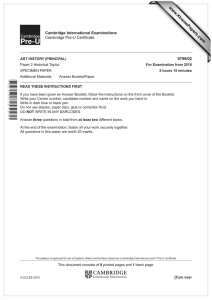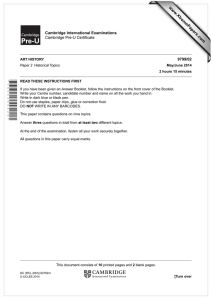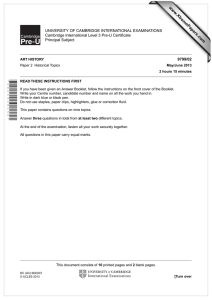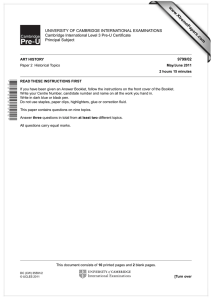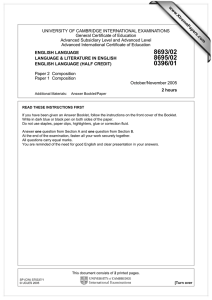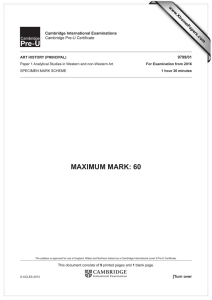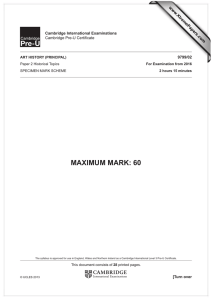www.XtremePapers.com
advertisement
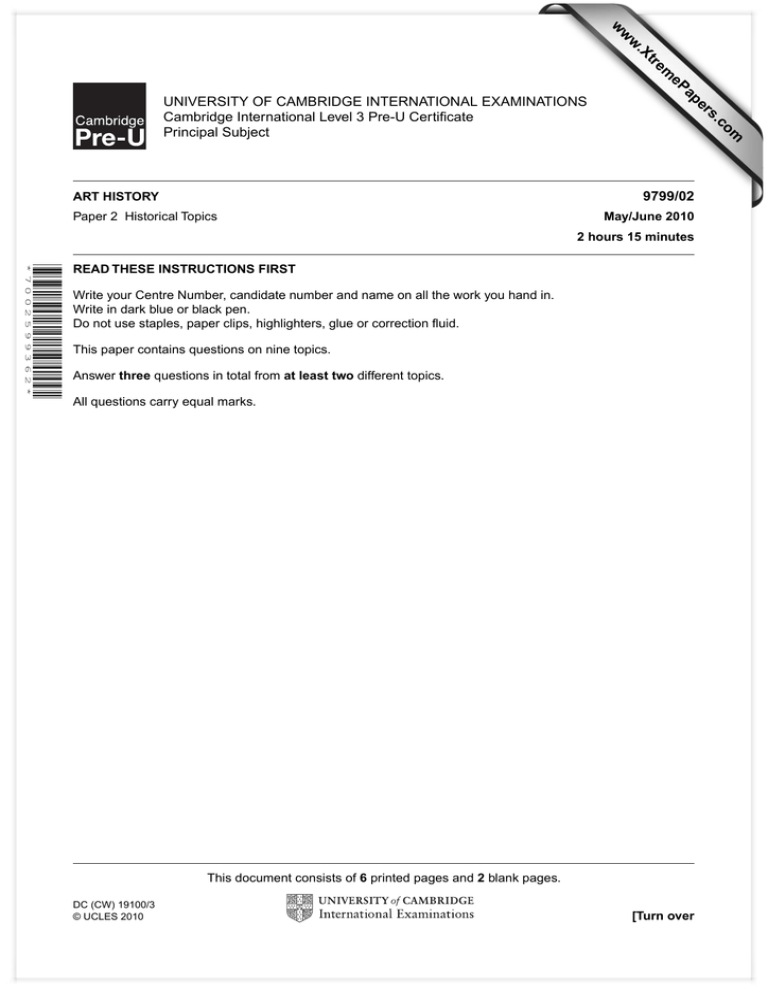
w w ap eP m e tr .X w om .c s er UNIVERSITY OF CAMBRIDGE INTERNATIONAL EXAMINATIONS Cambridge International Level 3 Pre-U Certificate Principal Subject 9799/02 ART HISTORY Paper 2 Historical Topics May/June 2010 2 hours 15 minutes *7002599362* READ THESE INSTRUCTIONS FIRST Write your Centre Number, candidate number and name on all the work you hand in. Write in dark blue or black pen. Do not use staples, paper clips, highlighters, glue or correction fluid. This paper contains questions on nine topics. Answer three questions in total from at least two different topics. All questions carry equal marks. This document consists of 6 printed pages and 2 blank pages. DC (CW) 19100/3 © UCLES 2010 [Turn over 2 Topic 1: The Art and Architecture of Classical Antiquity 1 With reference to the treatment of human form and pictorial space, what changes took place in relief sculpture in the Archaic period? 2 In what way was the unusual design of the Erechtheum on the Athenian acropolis determined by its location and purpose? 3 During the Hellenistic period, several sculptures commemorated naval or military victories. How did their design and location serve this purpose? 4 In what ways did the design and construction of either bath buildings or amphitheatres reflect the way that they were used? 5 “….the Ara Pacis Augustae [the Altar of Augustan Peace] … is undeniably a masterpiece of political and social propaganda.” (Strong, 1976) Do you agree with this statement? Topic 2: Art, Religion and Society in Romanesque Europe c. 1000–1200 1 Identify and give reasons for the similarities and differences between the churches that lay on the pilgrimage routes to Santiago. 2 Choose one or more portal(s) from 12th century French churches and explain how the style of the sculpture and the techniques employed gave rise to powerful religious images. 3 In this period, manuscripts were produced for a wide variety of purposes. In what ways did their design and illustration reflect their functions? 4 Choose one or more examples of metalwork from the Romanesque period and investigate the relationship between their functions and the materials and techniques employed in their manufacture. 5 What art historical evidence is there, if any, to support the view that from the second half of the 12th century onwards there was a dramatic increase in popular interest in the Virgin Mary? © UCLES 2010 9799/02/M/J/10 3 Topic 3: A New Heaven and New Earth: Gothic Art and Architecture c.1140–1540 1 Why has the early 12th century work at the Abbey church of Saint Denis often been considered to mark the origins of Gothic architecture? 2 Discuss the ways in which Books of Hours reflected the status, wealth and individuality of their owners. 3 What was more important in tomb design of the period, imagery concerned with the afterlife, or imagery which commemorated the status, character and achievements of the person for whom the tomb was built? 4 Claus Sluter was a very innovative artist. In what ways is this demonstrated by his work for Philip the Bold, Duke of Burgundy? 5 ‘The element of pride in the city’s appearance, and above all of a competitive determination to outshine their neighbours, was particularly strong in the Sienese..’. (Daniel Waley, ‘The Italian City Republics’, 1988). Discuss this statement as it applied to Siena in the 13th and 14th centuries, making reference to different types of buildings. Topic 4: Man, the measure of all things: the Early Italian Renaissance 1400–1500 1 What challenges did fresco painting present to artists and their workshops in the 15th century and how did they overcome them? 2 What contribution did Donatello make to the evolution of figure sculpture in Florence between c.1410 and c.1430? 3 What did either Federigo da Montefeltro, Duke of Urbino, or Ludovico II Gonzaga, Marquess of Mantua, hope to achieve by their extensive patronage of artists and architects? 4 With the exception of his work at Florence cathedral, how do the interiors of Brunelleschi’s churches compare with the interiors of Florentine churches in the Gothic style? You should refer in your answer to named examples of churches. 5 In his treatise ‘della Pittura’, Alberti gave advice to artists for producing more effective narrative paintings. Discuss this with reference to specific examples of such paintings. © UCLES 2010 9799/02/M/J/10 [Turn over 4 Topic 5: The Renaissance in Northern Europe 1420–1570 1 What aspects of the work of Netherlandish artists in the 15th century do you think particularly appealed to Italian patrons in this period? 2 Viewed as a whole, the work of Quentin Massys displays both conservative and innovative elements. With reference to named examples of his paintings, identify and discuss these two aspects of his work. 3 The figures in Veit Stoss’s sculpture express great emotional intensity. How did he achieve this effect in his work? 4 Analyse the blend of tradition and innovation in the design of French châteaux during the first half of the 16th century. 5 What were the functions of the portraits that Henry VIII commissioned from Holbein? Historical Topic 6: Faith Triumphant: Seventeenth Century Art and Architecture 1 How did Baroque artists in Rome express spiritual experiences through painting and sculpture? Discuss at least one painting and one sculpture. 2 Reynolds stated that Poussin was ‘naturalised in antiquity’. Explain what he meant with reference to at least two paintings. 3 How does Rubens use allegory to serve the interests of his patrons? 4 Explore the development of the use of light and dark in the work of Rembrandt. 5 To what extent does Velázquez reveal the inner characters of his sitters? Discuss with reference to specific portraits. © UCLES 2010 9799/02/M/J/10 5 Topic 7: Defining the Nation: Art and Architecture in Britain c. 1700–1860s 1 Discuss the acquisition of classical sculptures by British patrons who had made the Grand Tour and the arrangements that they made for their display. 2 What developments took place in the portraiture of children in 18th century Britain? You should refer to the work of at least two different British artists in your answer. 3 What impact did Joseph Wright of Derby’s membership of the ‘Lunar Society’ have on his paintings? 4 Samuel Palmer believed there was a higher reality that lay beyond the visible world. How did this belief find expression in the visionary landscapes of his Shoreham period (1825–1835)? 5 Which had the greater influence on the course of English architecture between c.1830 and c.1860, Pugin’s architecture or the books that he wrote and illustrated? Topic 8: Art, Society and Politics in Europe c.1790–1900 1 Mengs wrote that an ideal (in painting) ‘… depends upon selection of the most beautiful things in nature purified of every imperfection.’ Consider this example in the light of at least two examples of Canova’s sculpture. 2 Compare and contrast different representations of war from this period in the work of two artists. 3 How did Courbet challenge academic conventions in his work? 4 Compare and contrast contemporary representations of Baron Haussman’s new Paris. 5 How did technical innovation influence style? Discuss with reference to the work of Seurat or Cézanne. © UCLES 2010 9799/02/M/J/10 [Turn over 6 Topic 9: The Shock of the New: Art and Architecture in Europe and the United States in the 20th and 21st Centuries 1 Picasso’s development between 1900 and 1907 was dramatic. Give reasons why his work changed using specific examples. 2 In what ways can the Dessau Bauhaus 1925 be interpreted as a Socialist vision? 3 With reference to one film by Luis Buñuel, do you consider his work to be Surrealist? 4 What prompted the development of Land Art in America? Discuss examples of the work of at least two artists. 5 How does the contemporary artist treat the theme of the trauma of history? Give examples of the work of at least one artist. © UCLES 2010 9799/02/M/J/10 7 BLANK PAGE © UCLES 2010 9799/02/M/J/10 8 BLANK PAGE Permission to reproduce items where third-party owned material protected by copyright is included has been sought and cleared where possible. Every reasonable effort has been made by the publisher (UCLES) to trace copyright holders, but if any items requiring clearance have unwittingly been included, the publisher will be pleased to make amends at the earliest possible opportunity. University of Cambridge International Examinations is part of the Cambridge Assessment Group. Cambridge Assessment is the brand name of University of Cambridge Local Examinations Syndicate (UCLES), which is itself a department of the University of Cambridge. © UCLES 2010 9799/02/M/J/10
